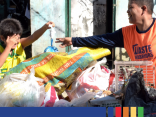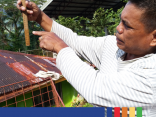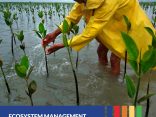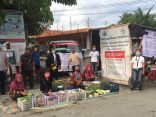(This report was first published online by ABS-CBNnews.com on 9 November 2014. Original version is available in this link.)
It is important to build on the traditional can-do attitude of Filipinos through further capacity building of the most vulnerable communities. According to ACCORD Executive Director Marieta Lupig Alcid, "'Preparedness is a long-term investment. Ang pinakamalaking factor ay ang effort ng tao (The biggest factor is the effort put in by people)." Quality and timely assistance must continue to support Haiyan-affected communities in recovery.
In photo: Carpenters train in how to Build Back Safer homes in Malinao, Aklan
(This report was first published online by ABS-CBNnews.com on 9 November 2014. Original version is available in this link.)
MANILA – Survivors of super typhoon ''Yolanda'' (international name ''Haiyan'') have continued to pick themselves up and rebuild, showing the resilience that the international community so admires in Filipinos. However, is resilience enough to deal with calamities? How long will it have be the only key to survival?
Survivors of super typhoon Yolanda said they are grateful for all the help given by donors and non-government organizations (NGOs). One year has passed, and they have been able to stay alive after being bludgeoned by one of the country’s worst natural disasters. However, they continue to question the government’s role in their lives.
It is not the government, but non-government agencies which did their part in helping the survivors get back on their feet, they said. Rumors that government officials sold relief goods as new stock in their stores, or that officials allegedly refused to accept funds to repair infrastructure as these will interfere with businesses they established only fuel many citizens’ ire.
“Mga tao ang nag-aahon sa sarili,” said Fara Gamalo, who lives in Tacloban and works at the local Regional Trial Court, in a phone interview with ABS-CBNnews.com. ''Kanya-kanya, tapos mas nakita ko pa, ang mga negosyo at negosyante ang nauna [na makaahon].''
Gamalo added that she feels it is not right that it was easier for businesses to get set up due to loans instead of the money going to loans for shelter repair or rebuilding.
''That is so wrong, hindi naman iyon para sa amin. Para iyon sa mga guests, international NGOs. Sino ang makikita mo na kumakain? Samantala kami, kung saan-saan kami nangungutang para makabili ng [pampaayos] sa bahay. Hindi [iyon] para sa masa.''
Odessa Echavez of Victory Island, meanwhile, said their community did not much feel the government’s helping hand, though they did get relief goods from the United States Agency for International Development (USAID), which was accompanied by the military, during the aftermath of Yolanda.
“Di ko po alam kung may dumating na galing sa gobyerno. Iyong tinanungnan ko, ang pagkakaalam nila, mga NGOs lang ang tumulong dito kasi nawawala po ito (Victory Island) sa mapa. Siguro di nila madiskubre,” she said.
On the other hand, Guiuan resident Junah Lyn Tampos said that they were able to receive help from the government and NGOs. However, their community still lacks programs for livelihood, and food sufficiency, despite their being able to fish, and receiving seedlings as well as materials for rebuilding.
“Nakaraos naman [kami], maganda na ang takbo, nakakaluwag-luwag dahil sa NGOs at sa mga proyekto. Nakatoka sa amin ang NGOs at gobyerno,” she said.
Bryllimemizer “Baibai” Berico, a college student who hails from Leyte and is now studying in Quezon City, meanwhile said that their town’s mayor was able to guide them after the onslaught of the storm, and also shared with them rice that he was able to save from destruction.
“Iyong mayor po namin, sabi niya sa amin, huwag kaming mag-alala. May rice mill siya, mamimigay siya ng bigas. Tipirin niyo lang po ang bigas,” he said.
“Ang maganda po sa mayor namin, ang mga debris, naglinis sila agad para madaanan agad [ang kalye] para makadaan agad ang relief.”
However, after aid came, he and his family felt that there was something not quite right with the government.
“Bilang nasalanta rin po, ang tanong namin, nasaan na iyong [pera na ipinamigay ng mga NGO, at pamahalaan]? Hindi naman ipinamahagi sa amin. Parang unfair naman. Nagka-issue rin kasi sa municipality namin. May mga relief na nakatago, naka-stock lang siya. Hindi ipinamigay until naging rotten na siya.”
A representative of the Department of Social Welfare and Development assigned to their municipality, he said, did not distribute the relief goods given to the community.
“Tinapon lang sa ilog, eh may nakakakita tapos ni-report sa mayor,” he said.
Quick progress
Despite Filipinos’ mixed views on the progress of the relief, rebuilding, and rehabilitation efforts in typhoon-hit areas, the director for operations of an international NGO said that compared to progress when Japan was hit by a tsunami, and when Myanmar was devastated by a cyclone, recovery from Yolanda has gone quicker than in other disaster-hit areas.
According to Michel Rooijackers, deputy country director for operations of international NGO Save the Children, considering the large scale of the disaster, affecting an area more than 700 kilometers long and hundreds of kilometers wide, progress here has been good.
“Even in Japan they took a long time to recover, and if we compare the progress, with the 2004 tsunami, it is quicker here. So there is a lot to celebrate, but there is also a lot of work to be done,” he said.
This, he said, is largely due to the can-do attitude that is very prevalent in the Philippines. However, progress is also due to a multitude of factors, including the volume of assistance coming in and the number of programs and people helping the survivors.
According to Marieta Lupig-Alcid of Assistance and Cooperation for Community Resilience and Development (ACCORD), while local officials they have been able to talk to during their LGU conference confessed they are not satisfied with their own governments’ efforts, and that a lot still has to be done, the progress of recovery has been helped by the own local’s fortitude.
“May mga nagsasabi na kinukumpara tayo sa ibang malalaking emergencies, sinasabi nila na parang on track naman. Pero kapag itanong mo ang beneficiaries, talagang nauna na sila, ginawa na nila. Ang large part talaga ay ang mga tao ang gumawa,” she said.
The view of beneficiaries and affected communities that a lot has to be done is due to their own experience of how hard it is to rebuild using very limited resources, and with little support, Alcid said.
“Hindi sa minamaliit ko ang aming response at ang response ng iba, pero kung titingnan mo ang mga pangangailangan ng mga affected communities, kahit ang mga relief pack namin ay hindi maliit, ang mga communities, kung ikukumpara mo sa pangangailangan nila na pang-araw-araw over a long period of time, sira ang kabuhayan, kaunti lang iyon. Ang pinakamalaking factor ang effort ng mga tao.”
Biggest gaps
If there is one thing that survivors and benefactors seem to agree on, it is that more has to be done — there is a lack of shelter and livelihood in many places, and aid for special cases such as the disabled and psychologically disordered are difficult to obtain.
Fara Gamalo of Tacloban shared that it has been difficult for her to get support for her husband, who suffered a stroke a week before Yolanda hit.
''Walang tumutulong sa asawa ko, sa gamot. Kapatid niya ang tumutulong. Sila ang sumasagot sa gamutan, sa finance,” she said, adding that while there are special loans and grants for entrepreneurs, there does not seem to be anyone offering financial aid for those who need to buy medicine and pay for therapy for their sick family members.
Genive Aumentado, who currently resides in a tent city in Palo, Leyte, also said she is unable to provide therapy for her son, who social workers said has autism, and was traumatized by Yolanda, as it is expensive.
“May autism siya, ADHD. May trauma din siya. Nalaman ko lang iyon dito sa tent city. Pinapa-therapy pero hindi ko kaya kasi P1,500 ang consultation. Naghahanap ako ng mag-sponsor sa kanya [para makapagpa-therapy siya. Walang inooffer dito na tulong. Hindi kami naka-appeal doon sa Maynila,” she said.
Rooijackers meanwhile said that while they are doing livelihood programs, as are other NGOs, livelihood and shelter remain “the biggest gaps of them all”.
In addition, he said, for the recovery to keep going, they have to stimulate the economy. “If consumers don’t have any money, then the producers cannot also sell a lot so that’s the circle we’re trying to restore.”
Ready for action
Odessa Echavez of Victory island said that what their community needs is to transfer to a different place. “Iyong kailangan lang po namin, kahit sa isla namin, malilipatan talaga namin,” she said, expressing little faith that any kind of preparation on their island would ensure their survival, as it is surrounded by water.
''Wala na sa aming mapapag-bakwitan.''
However, NGOs said that it is still important to focus on disaster preparedness.
Rooijackers said that this could start as early as possible, when children are taught how to prepare for calamities in school. Thus, they are coordinating with teachers and the Department of Education regarding evacuation plans and what should be done in case there is a typhoon.
“At least we must reduce the impact of a typhoon that’s why we need at least three years to work on the recovery, but also to work on the resilience for the next so that the impact is less,” he said.
This was echoed by Alcid, who emphasized the importance of enhancing Filipino resilience by giving them the knowledge and facilities to weather storms and other natural disasters in the future such as triggering smarter farming techniques to allow food supply to remain stable during calamities.
''Investment ang preparedness. Tiya-tiyagain mo para maintindihan ng mga tao. Kahit generally capable ang mga tao, resilient ang sinasabi, hindi dahil tamad siya, hindi minsan maipag-kasya ang ibinibigay [na pera o resources],'' Alcid said.
However, Rooijackers added that support from donors, especially Filipinos abroad, was “terrific”, and they were able to raise substantial funds and create programs.
“The challenge is gonna be, after this weekend, we would like to urge the public and private to keep committed to the recovery of the Visayas region. There is more work to be done, and more resources needed to sustain the recovery and make sure that everybody is back or better,” he said.
In photo: Carpenters train in how to Build Back Safer homes in Malinao, Aklan





